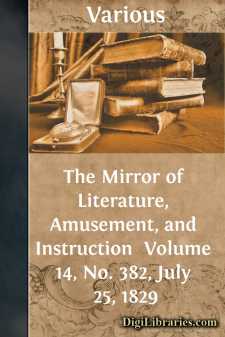Categories
- Antiques & Collectibles 13
- Architecture 36
- Art 48
- Bibles 22
- Biography & Autobiography 813
- Body, Mind & Spirit 142
- Business & Economics 28
- Children's Books 14
- Children's Fiction 11
- Computers 4
- Cooking 94
- Crafts & Hobbies 4
- Drama 346
- Education 46
- Family & Relationships 57
- Fiction 11829
- Games 19
- Gardening 17
- Health & Fitness 34
- History 1377
- House & Home 1
- Humor 147
- Juvenile Fiction 1873
- Juvenile Nonfiction 202
- Language Arts & Disciplines 88
- Law 16
- Literary Collections 686
- Literary Criticism 179
- Mathematics 13
- Medical 41
- Music 40
- Nature 179
- Non-Classifiable 1768
- Performing Arts 7
- Periodicals 1453
- Philosophy 64
- Photography 2
- Poetry 896
- Political Science 203
- Psychology 42
- Reference 154
- Religion 513
- Science 126
- Self-Help 84
- Social Science 81
- Sports & Recreation 34
- Study Aids 3
- Technology & Engineering 59
- Transportation 23
- Travel 463
- True Crime 29
The Mirror of Literature, Amusement, and Instruction Volume 14, No. 382, July 25, 1829
by: Various
Categories:
Description:
Excerpt
POPE'S TEMPLE, AT HAGLEY
Reader! are you going out of town "in search of the picturesque"—if so, bend your course to the classic, the consecrated ground of HAGLEY! think of LYTTLETON, POPE, SHENSTONE, and THOMSON, or refresh your memory from the "Spring" of the latter, as—
Courting the muse, thro' Hagley Park thou strayst.
Thy British Tempe! There along the dale,
With woods o'erhung, and shagg'd with mossy rocks,
Whence on each hand the gushing waters play,
And down the rough cascade white dashing fall,
Or gleam in lengthen'd vista through the trees,
You silent steal; or sit beneath the shade
Of solemn oaks, that tuft the swelling mounts
Thrown graceful round by Nature's careless hand,
And pensive listen to the various voice
Of rural peace; the herds, the flocks, the birds,
The hollow-whispering breeze, the 'plaint of rills,
That, purling down amid the twisted roots
Which creep around their dewy murmurs shake
On the sooth'd ear.
Such is the fervid language in which the Poet of the year invoked
"LYTTLETON, the friend!"
Yet these lines will kindle the delight and reverence of every lover of Nature, in common with the effect of the Seasons on the reader, who "wonders that he never saw before what Thomson shows him, and that he never yet has felt what Thomson impresses."
But we quit these nether flights of song to describe the locality of Hagley Park, of whose beauties our Engraving is but a mere vignette, and in comparison like holding a candle to the sun. The village of Hagley is a short distance from Bromsgrove, in Worcestershire, whence the pleasantest route to the park is to turn to the right on the Birmingham road, which cuts the grounds into two unequal parts. The house is a plain and even simple, yet classical edifice. Whately, in his work on Gardening, describes it as surrounded by a lawn, of fine uneven ground, and diversified with large clumps, little groups, and single trees; it is open in front, but covered on one side by the Witchbury hills; on the other side, and behind by the eminences in the park, which are high and steep, and all overspread with a lofty hanging wood. The lawn pressing to the front, or creeping up the slopes of three hills, and sometimes winding along glades into the depth of the wood, traces a beautiful outline to a sylvan scene, already rich to luxuriance in massive foliage, and stately growth. The present house was built by the first Lord Lyttleton, not on, but near to, the site of the ancient family mansion, a structure of the sixteenth century. Admission may be obtained on application to the housekeeper; and for paintings, carving, and gilding, Hagley is one of the richest show-houses in the kingdom.
Much as the visiter will admire the refined taste displayed within the mansion, his admiration will be heightened by the classic taste in which the grounds are disposed. A short distance from the house, embosomed in trees, stands the church, built in the time of Henry III.; with a sublime Gothic arch, richly painted windows, and a ceiling fretted with the heraldic fires of the Lyttleton family, whose tombs are placed on all sides; among them, the resting-place of the gay poet is distinguished by the following plain inscription:—
This unadorned stone was placed here
By the particular desire and express
Directions of the Right Honourable
GEORGE, LORD LYTTLETON,
Who died August 22, 1773, aged 64....












